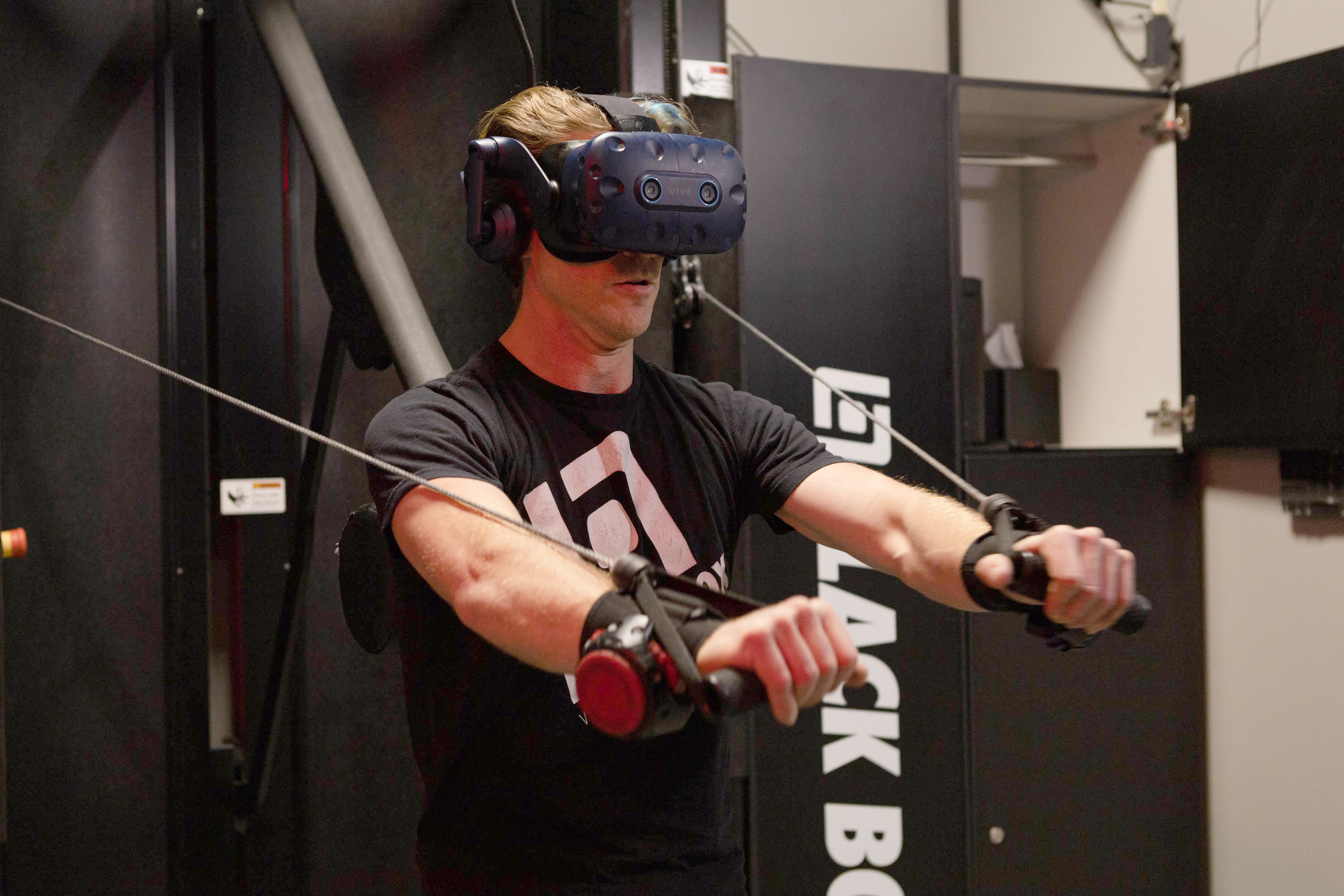Standing inside a black box with cuffs cutting into my wrists, goggles pressing into my head and tethered to the ceiling, I sweatily wonder what bizarre thing I will do next in the name of journalism.
No, I’m not at a kink fair or in a sensory deprivation tank—I’m testing out the exercise routine at San Francisco’s first and only virtual reality gym, Black Box.
The Mid-Market boutique gym opened in 2019 and managed to survive the pandemic that folded well-established gyms and yoga studios.
Co-founders Ryan DeLuca and Preston Lewis built what they call the “crown jewel” of their Idaho-based business in high-tech San Francisco and often use the word “disrupt” to characterize their influence on the fitness industry, a verb favored by techies and one that may or may not be borne out by their backgrounds in the supplement and bodybuilding industries.
With thoughts of video-game villains drifting through my mind, I wondered: Could a VR gym transform how people work out? More importantly, could it transform me into a svelte superhero?
Not-So-Brave New World
Black Box doesn’t have the trappings of a typical gym: no sets of weights, cardio machines, mirrored walls. True to its name, I’m led to a black-walled box, one that feels stuffy even with a fan whirring overhead. After I don a headset and wrist “pucks,” a woman’s soothing voice guides me through training videos that teach me to slice and punch the air and to employ a retractable arm for chest presses and rows.
The game’s concept is simple. Users are in an arena, trying to keep enemies from getting to a crystal—just as you’re trying to capture theirs. I defend and attack by quickly doing air slices and punches and those rows and presses.
The time ticks by, and sweat accumulates under my headset, but I can’t say I’m having fun. Something about the whole experience—the groaning engagement of the arm, the claustrophobic box, the awkwardness of the headgear—makes me long to jump in a swimming pool or step on a yoga mat.
I think about what Lewis told me: “VR is going to change the world. It’s the final platform.”
But so far, I’m not convinced.
Sweat Equity
Four years in, Black Box continues to struggle with educating the public about its signature workout, a combination cardio and resistance workout in a 30-minute session that has an automatic weight setting to adjust to your abilities.
“The main challenge is getting people to understand what a virtual reality strength workout is,” said Ralph Rajs, Black Box’s chief operating officer.
Education is a bigger issue than even the “Doom Loop” plaguing Downtown, Rajs said, despite the fact that the Mid-Market neighborhood has been hit particularly hard by retail and office vacancies.
Because Black Box depends on proprietary equipment that’s not portable, maintaining expensive brick-and-mortar locations is a must. It adds to the overhead of a VR exercise program that simple headset routines like Supernatural don’t have.
While membership has returned to pre-pandemic levels, business could be better.
“We’re still not quite where we’d like to be with memberships,” Rajs said.
The gym has kept prices the same over the past year (between $79 to $149 on sale and $240 to $320 full price monthly, which is in line with the cost of a premium gym membership), including a more than 50% discount offer to encourage more members to join. Three out of the six locations closed in the past year—the remaining three are in San Francisco and Idaho—and its membership and prices have remained flat, even in a time of runaway inflation.
Rajs remains upbeat about Black Box’s future, saying its novelty guarantees success—there’s simply no one else offering what they do.
Lewis, the co-founder, says creating what he sees as an addictive routine, he believes Black Box solves the fitness problem that’s always been thorniest: getting people to stick to their workouts.
“It’s Nike meets Marvel,” Lewis said of Black Box, claiming that members love the gym because of its “addictive” nature—a routine that makes sweating your butt off feel like fun and games. Customers also love the sense of competition created by the commenting, liking and leaderboard features built into the Black Box mobile application, Lewis said.
I pull off my headset and place it in the “Clean Box,” a small black box that’s supposed to kill bacteria with ultraviolet light. But I can’t help but wonder about all the strangers’ sweat on those non-machine-washable goggles.
Walking out of Black Box, I feel less like a superhero and more like a kid who has just crawled off a sticky couch in their parents’ basement.
